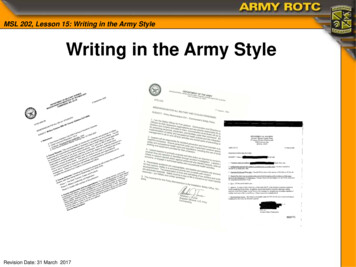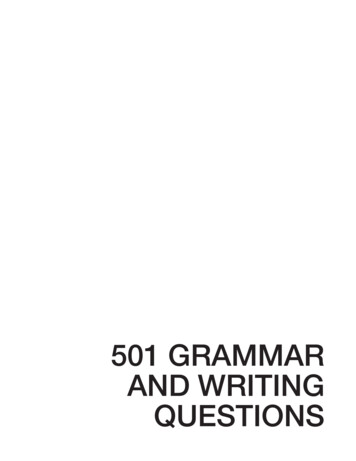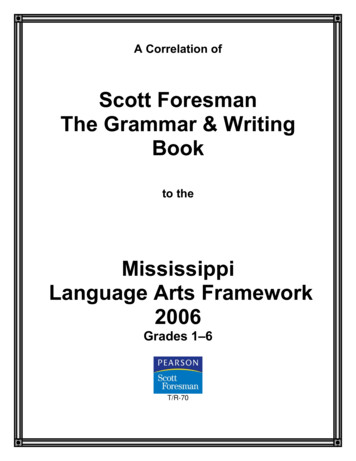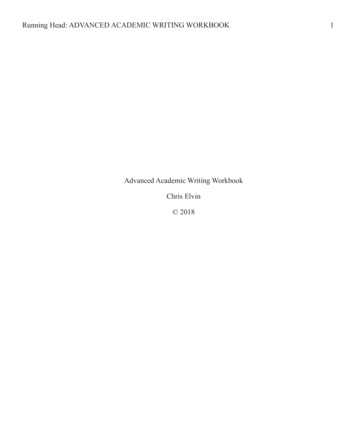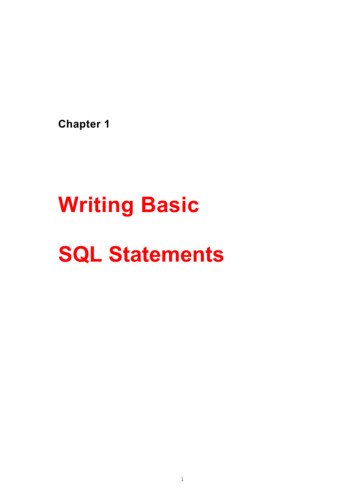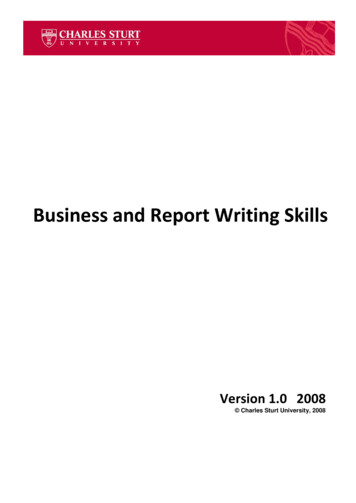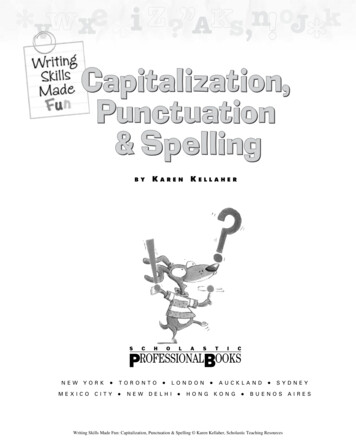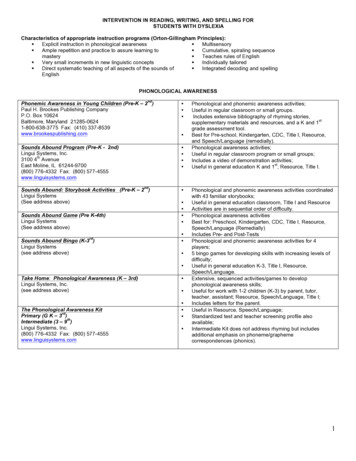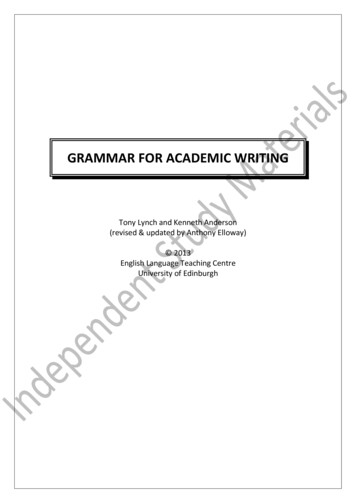
Transcription
GRAMMAR FOR ACADEMIC WRITINGTony Lynch and Kenneth Anderson(revised & updated by Anthony Elloway) 2013English Language Teaching CentreUniversity of Edinburgh
GRAMMAR FOR ACADEMIC WRITINGContentsUnit 1 PACKAGING INFORMATIONPunctuationGrammatical construction of the sentenceTypes of clauseGrammar: rules and resourcesWays of packaging information in sentencesLinking markersRelative clausesParagraphingExtended Writing Task (Task 1.13 or 1.14)Study Notes on Unit1123456891112Unit 2 INFORMATION SEQUENCE: DescribingOrdering the informationDescribing a systemDescribing proceduresA general procedureDescribing causal relationshipsExtended Writing Task (Task 2.7 or 2.8 or 2.9 or 2.11)Study Notes on Unit1616202122222425Unit 3 INDIRECTNESS: Making requestsWritten requestsWouldThe language of requestsExpressing a problemExtended Writing Task (Task 3.11 or 3.12)Study Notes on Unit27283033343536Unit 4 THE FUTURE: Predicting and proposingVerb formsWill and Going to in speech and writingVerbs of intentionNon-verb formsExtended Writing Task (Task 4.10 or 4.11)Study Notes on Unit40404344454647ii
GRAMMAR FOR ACADEMIC WRITINGUnit 5 THE PAST: ReportingPast versus PresentPast versus Present PerfectPast versus Past PerfectReported speechExtended Writing Task (Task 5.11 or 5.12)Study Notes on Unit49505154565960Unit 6 BEING CONCISE: Using nouns and adverbsPackaging ideas: clauses and noun phrasesCompressing noun phrases‘Summarising’ nounsExtended Writing Task (Task 6.13)Study Notes on Unit646568717374Unit 7 SPECULATING: Conditionals and modalsDrawing conclusionsModal verbsWouldAlternative conditionalsSpeculating about the pastWould haveMaking recommendationsExtended Writing Task (Task 7.13)Study Notes on Unit77777879808183848687iii
GRAMMAR FOR ACADEMIC WRITINGIntroductionGrammar for Academic Writing provides a selective overview of the key areas of English grammar that youneed to master, in order to express yourself correctly and appropriately in academic writing. Those areasinclude the basic distinctions of meaning in the verb tense system, the use of modal verbs to expressdegrees of certainty and commitment, and alternative ways of grouping and ordering written information tohighlight the flow of your argument.These materials are suitable for taught and research postgraduate students.Study NotesThis course contains Study Notes at the end of each unit, providing answers and comments on the twotypes of exercise in the course: closed tasks - to which there is a single correct answer or solution; open tasks - where you write a text about yourself or your academic field. For these tasks wehave provided sample answers (some written by past students) inside boxes. We hope you willfind what they have written both interesting and useful in evaluating your own solutions.Note: every unit contains some suggested Extension Tasks – these are open tasks. Please do not send thesetasks to us. If possible, show your answers to the open tasks to another student and ask them for theircomments and corrections.Recommended BooksIf you are interested in continuing to work on your grammar/vocabulary, I can recommend the following:1. Grammar Troublespots: A guide for Student Writers by A. Raimes (Cambridge University Press,2004).This is designed to help students identify and correct the grammatical errors they are likely to makewhen they write.2. Oxford Learner’s Wordfinder Dictionary by H. Trappes-Lomax (Oxford University Press, 1997).This is an innovative dictionary, designed to help you in the process of writing – unlike aconventional dictionary, which helps you understand new words when you are reading.iv
Grammar for Academic Writing: Unit 1 - Packaging information1PACKAGING INFORMATIONIn this first unit we look at ways of organising your writing into ‘packages’ ofinformation that will make your meaning clear to the reader. To do that, we need toconsider three levels of packaging of English: punctuation within and between parts of the sentence the grammar of sentence construction paragraphingPunctuationTask 1.1Write in the names for these punctuation marks in the boxes below::;“ ”( )[ ]*&@#/\‘ ’Task 1.2All the punctuation has been removed from the text below. Read the whole text and put in slasheswhere there you think the sentences end. Then punctuate each sentence.the university of edinburgh unlike other scottish universities is composed of colleges there arethree of them sciences and engineering humanities and social sciences and medicine and veterinarymedicine each college covers both undergraduate and graduate programmes of study althoughstudents are generally admitted to one college only they may have the opportunity to studysubjects of another undergraduate programmess generally last three years or four for honoursthere is an extensive variety of postgraduate programmes of study including a 9 month diploma a12 month masters and doctoral research programmes lasting at least 36 months1
Grammar for Academic Writing: Unit 1 - Packaging informationGrammatical construction of the sentenceTerminologyAny discussion of grammar requires some knowledge of the principal grammaticalterms, so here’s a quick test to check whether you need to brush up your knowledgeof terminology.Task 1.3Write down one example (not a definition) of each of these terms:termexamplea clausea phrasean auxiliary verba transitive verban uncountable nounindirect speecha phrasal verban adverb2
Grammar for Academic Writing: Unit 1 - Packaging informationTypes of clauseTask 1.4Match the four clause types on the left with the appropriate definition on the right:1 main clausea clause joined to another by ‘and’, ‘but’, or ‘or’2 relative clauseb clause that can stand independently3 co-ordinate clausec clause beginning with ‘who’, ‘which’, etc.4 subordinate claused clause that is dependent on another clauseThis terminology is helpful because it allows us to discuss the structure of a text (orsequence of sentences), which is a fundamental part of this course. It provides a wayof analysing the formal components of a text - phrases, clauses, sentences,paragraphs - even if the content is hard to understand, as illustrated in the nexttask.Task 1.5The text below is part of an abstract for a talk. You may find it difficult to understand, unless you are astudent of cognitive science or artificial intelligence. That doesn’t matter! What we want you to do isto analyse it grammatically into the categories shown under the box. Tick the categories to showwhich of them are present in the six sentences.Some Reasons for Avoiding Supervised Nets, and Ways of Doing SoAiBNeural networks can be divided into supervised and unsupervised. Supervised networks,such as the multilayer perceptron trained with backpropagation on a sum-of-squares errorfunction, are useful for representing how some properties of the environment co-vary withCothers (function approximation), but are biologically dubious. Unsupervised networks, suchas the Self-organizing Map, are often more biologically plausible, but are used almostexclusively to represent the resting state of the environment (density estimation).DIn this talk I will argue that, for a common class of problem, it is wrong to use unsupervisedEnets. I will go on to describe some unsupervised models that do the same job better, andFthen try to motivate them from a computational and biological perspective. There will besome maths but more pictures.main clauseSentence A:coordinateclause Sentence B:Sentence C:Sentence D:Sentence E:Sentence F:3subordinateclauserelative clause
Grammar for Academic Writing: Unit 1 - Packaging informationGrammar: rules and resourcesGrammar is often defined as the rule system of a language, but it is also useful tothink of it as a resource for expressing meaning. For example, when we talk ofsomeone ‘knowing’ the Present Perfect in English, we mean that they know how toform it ( by combining the auxiliary verb have with the past participle of the relevantverb), but more importantly in which situations it is used and which meanings it canconvey. Thinking of grammar as primarily ‘rules’ tends to make people think there isa one-to-one relationship between grammar and meaning. As we will see in the nexttask, the same meaning can be expressed in different ways, and even with differenttenses.Task 1.6Think carefully about the meaning of this sentence:It's eleven years since the SDA Conference was last held here in Edinburgh.Complete the eight sentences below in ways that express the same meaning as the one above.A The last time.B The SDA Conference . last.C It in 2000.D Eleven years have.E This is the first.F 2000.G The SDA Conference hasn't.H Not for eleven years.That task highlights grammar as a resource. One important technique for extendingyour knowledge of English grammar is to analyse the texts you read for your degreecourse and to notice the variety of ways of expressing the same basic meaning.4
Grammar for Academic Writing: Unit 1 - Packaging informationWays of packaging information in sentencesEnglish offers three ways of showing the relationship between ideas:SequenceResearch grants from the British government are getting scarcer. As a result, universities arehaving to seek funding from private industry.Co-ordinationResearch grants from the British government are getting scarcer and universities are havingto seek funding from private industry.SubordinationAs research grants from the British government are getting scarcer, universities are having toseek funding from private industry.orUniversities are having to seek funding from private industry because research grants aregetting scarcer.On the next page is a table showing some of the commonest linking markers:sentence openers and conjunctions (used in co-ordination and subordination).Task 1.7Put an appropriate marker in the space in each sentence:AYou can attend a graduation ceremony and receive your degree certificate from theChancellor of the University. you can graduate in absentiaand get the certificate sent by post.BIn some areas of England, domestic water consumption is now subject to metering.some people on low incomes are washing less often.CApproximately 120 matriculated students take ELTT courses at ELTC each year.they take a diagnostic test of English known as TEAM.DSigrid scored less than 50% on TEAM. she did not apply forEnglish courses at ELTC because she should have taken ELBA, the test for non-graduatingstudents.5
Grammar for Academic Writing: Unit 1 - Packaging informationLINKING MARKERS1 SENTENCE ONCHOICE/NEGATIVECONDITIONTIME ORDER/LISTINGNote:2 CONJUNCTIONS2ACo-ordinating.and .In addition [to NP], .Moreover, .Also, .Apart from [NP], .Furthermore, .2BSubordinating, who., which., where., when.not only .,but also .However, .Nevertheless, .On the other hand, .In contrast, .In spite of [NP], .Despite [NP], . but .(and) yet.(and) so.So.As a result.Consequently.Therefore.Thus.Hence.For this reason.Because of [NP],.(and) hence.In that case,.If so,.Then,.and.and (then).or (else).Alternatively, .Otherwise,.Instead of [NP],.Rather than [NP],.If .Prior to [NP],.Before [NP],.Finally / Lastly,.(and (then).although.whereas.while.in spite of the fact that.despite the fact that.so.so that.because.due to the fact that.if.as/so long as.If. not.unless.before.after., after which.when.now that.[NP] Noun Phrase, which may include a noun, or a verbal noun (-ing form):e.g.Instead of complaints,Instead of complaining,it would be better to offer advice6
Grammar for Academic Writing: Unit 1 - Packaging informationTask 1.8Now do the same for this text about how parents correct or ignore their children’s language errors.Learning conditionsiiThe way in which parents correct their children’s errors in their first language tends to belimited to corrections of meaning. , in informal learning of a secondlanguage (i.e. not in the classroom) errors that do not interfere with meaning are usuallyignored, because most people would feel they were being impolite if they interrupted andcorrected someone who was trying to have a conversation with them! ,they may ‘correct’ if they cannot understand what the speaker is trying to say., errors of grammar and pronunciation are rarely commented on, but thewrong choice of word may receive a comment from the confused listener. The only placewhere the correction of language errors is common is the language classroom.Task 1.9Rewrite the information below as TWO or THREE sentences. That involves deciding how the ideas arelogically related, and then using a marker or conjunction (co-ordinating or subordinating) to matchyour meaning.Learning English is not easy.Learning German is in some ways more difficult.German has different articles for masculine, feminine and neuter nouns.You have to change the endings of adjectives to match the nouns.This is harder for speakers of English than for speakers of French.French also uses adjectival endings.People say that knowing English helps you to start learning German.When you have passed the elementary stages, English is less help.At an advanced level, knowledge of English is no help at all.7
Grammar for Academic Writing: Unit 1 - Packaging informationRelative clausesLANGUAGE BOX: Relative connectorsin subject positionThe student who (or that) saw me yesterday was absent this morning.The book which (or that) proved most helpful was the one by McKenzieas objectThe supervisors who (or that, or less commonly whom) students appreciate most arethose that give the clearest advice.The equipment which (or that) I avoid using is the gas spectrometer.[N.B. In object position,
Grammar Troublespots: A guide for Student Writers by A. Raimes (Cambridge University Press, 2004). This is designed to help students identify and correct the grammatical errors they are likely to make when they write. 2. Oxford Learner’s Wordfinder Dictionary by H. Trappes-Lomax (Oxford University Press, 1997). This is an innovative dictionary, designed to help you in the process of writing .

